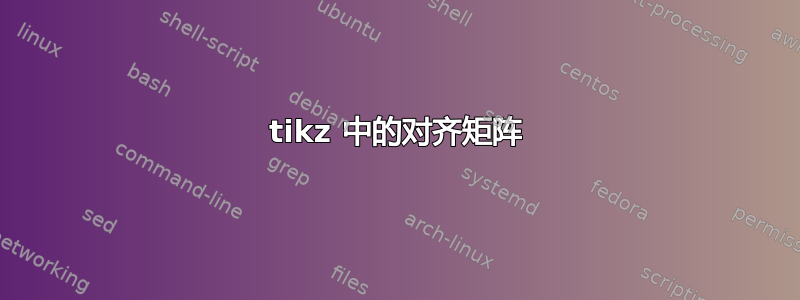
我是 PGF/TikZ 的新手,我想绘制矩阵,使其第一行水平对齐,并在每个术语下垂直对齐。
我的第一个粗略代码尝试是:
\documentclass{standalone}
\usepackage[pdftex,active,tightpage]{preview}
\usepackage{tikz}
\usepackage{amsmath,amsfonts,amsthm,bm}
\PreviewEnvironment{tikzpicture}
\newcommand{\x}{\bm{\mathrm{x}}}
\newcommand{\n}{\mathbf{n}}
\newcommand{\y}{\mathbf{y}}
\newcommand{\D}{\mathbf{D}}
\newcommand{\A}{\mathbf{A}}
\renewcommand{\H}{\mathbf{H}}
\begin{document}
\begin{tikzpicture}[scale=1]
\begin{scope}[xshift=0]
\node (xhat) at (0, 0) {$\hat{\x}$};
\node at (1, -2pt) {$ = $};
\node (D) at (2, 0) {$\D^H$};
\node (A) at (3, 0) {$\A^H$};
\node (H) at (4, 0) {$(\H$};
\node (x) at (5, 0) {$\x$};
\node at (6, 0) {$+$};
\node (HB) at (7, 0) {$\H_B$};
\node (XB) at (8, 0) {$\x_B$};
\node at (9, 0) {$+$};
\node (n) at (10, 0) {$\n)$};
\end{scope}
\begin{scope}[scale=1/8]
% \draw[help lines] (0,0) grid (33,-9);
\draw[thick,yscale=2,shift={([xshift=-12,yshift=-16]xhat)}] (0,0) grid (1,-1);
\draw[thick,xscale=4,yscale=2,shift={([xshift=-18,yshift=-16]D)}] (0,0) grid (1,-1);
\draw[thick,xscale=8,yscale=4,shift={([xshift=-18,yshift=-16]A)}] (0,0) grid (1,-1);
% \draw[] (x) grid ++(1,-2); % x
\draw[thick,yscale=2,shift={([xshift=-12,yshift=-16]x)}] (0,0) grid (1,-1);
\end{scope}
\end{tikzpicture}
\end{document}
答案1
像这样?
其中一种可能性是使用matrix库:
\documentclass[tikz, border=3mm]{standalone}
\usetikzlibrary{matrix}
\usepackage{amssymb}
\begin{document}
\begin{tikzpicture}
\matrix (m) [matrix of math nodes,
nodes={inner xsep=0pt},
nodes in empty cells,
column sep=1pt,
row sep=0pt,
row 2/.style = {nodes={draw, minimum height=3ex}}
]
{
\hat{\mathbf{x}}
& = & \mathbf{D}^H & \mathbf{A}^H
& ( & \mathbf{H} & \mathbf{x}
& + & \mathbf{H}_B & \mathbf{x}_B
& + & \mathbf{n}
& ) \\
\hphantom{x}
& |[draw=none]| & \hphantom{D^H} & \hphantom{A^H}
& |[draw=none]| & \hphantom{H} & \hphantom{x}
& |[draw=none]| & \hphantom{H_B} & \hphantom{x_B}
& |[draw=none]| & \hphantom{n}
& |[draw=none]| \\
};
\end{tikzpicture}
\end{document}
答案2
以下是 Steven B. Seglets 和 Zarko 的答案的替代方案,它结合了Steven 的回答很好使用标准方程,包括\left(和之类的方程\right),并灵活地使用 Ti钾Z,这使得可以向框添加任何所需的功能,如填充、阴影等。
\documentclass{article}
\usepackage{amsmath,amssymb,braket,tikz}
\usetikzlibrary{tikzmark,calc}
\begin{document}
\newcounter{mymark}
\newcommand{\Mark}[1][]{\stepcounter{mymark}\tikzmark{m-\themymark}}
\begin{equation}
\Mark \hat{\mathbf{x}}
\Mark = \Mark \mathbf{D}^H \Mark \mathbf{A}^H
\Mark \left( \Mark \mathbf{H}\, \Mark \mathbf{x}
\Mark + \Mark \mathbf{H}_B \Mark \mathbf{x}_B
\Mark + \Mark \mathbf{n} \Mark\right)
\end{equation}
\begin{tikzpicture}[overlay,remember picture]
\foreach \X [evaluate=\X as \Y using {int(\X+1)}] in {1,3,4,6,7,9,10,12}
{\draw ([yshift=-3pt,xshift=1pt]pic cs:m-\X) rectangle
([yshift=-12pt,xshift=-1pt]pic cs:m-\Y); }
\end{tikzpicture}
\end{document}





